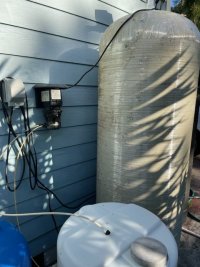CountryBumkin
Active Member
Recently I had my water softener and carbon filter tanks rebeded. The guy doing the work said I should be reading some chlorine in the large holding tank - but nothing showing on the water test (Pool chlorine test kit).
I had this system installed 20 years ago and the only instruction I got then was to add one gallon of bleach (6% I think) to the Chlorine tank when it is low. He never mentioned checking the level in the large holding tank.
However, the new Water Service company (the original water guy retired) said I should add 2.5 gallons of the stronger chlorine (get it at Pool Supply store) rather than what I have been doing. And I should see a trace amount of chlorine in the holding tank.
To be honest, I may have misunderstood the instructions form the installer, 20 years ago, and I have no instructions on how much chlorine I should be using, but the water seemed fine.
The reason I had the new company come out and rebed, is because I'm now smelling sulfur - and the last rebed was ten years ago.
Testing at the top of the holding tank (see photo) shows zero chlorine in tank (also, does it matter if I test at the top or bottom hose bib on the tank?

So what is the proper amount of chlorine to add the Chlorine tank (its a 25 gallon tank). The injection pump is set at mid point ("5").
I had this system installed 20 years ago and the only instruction I got then was to add one gallon of bleach (6% I think) to the Chlorine tank when it is low. He never mentioned checking the level in the large holding tank.
However, the new Water Service company (the original water guy retired) said I should add 2.5 gallons of the stronger chlorine (get it at Pool Supply store) rather than what I have been doing. And I should see a trace amount of chlorine in the holding tank.
To be honest, I may have misunderstood the instructions form the installer, 20 years ago, and I have no instructions on how much chlorine I should be using, but the water seemed fine.
The reason I had the new company come out and rebed, is because I'm now smelling sulfur - and the last rebed was ten years ago.
Testing at the top of the holding tank (see photo) shows zero chlorine in tank (also, does it matter if I test at the top or bottom hose bib on the tank?
So what is the proper amount of chlorine to add the Chlorine tank (its a 25 gallon tank). The injection pump is set at mid point ("5").

